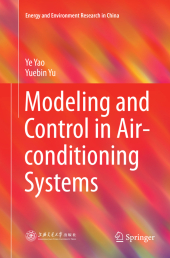 Neuerscheinungen 2018Stand: 2020-02-01 |
Schnellsuche
ISBN/Stichwort/Autor
|
Herderstraße 10
10625 Berlin
Tel.: 030 315 714 16
Fax 030 315 714 14
info@buchspektrum.de |

Ye Yao, Yuebin Yu
(Beteiligte)
Modeling and Control in Air-conditioning Systems
Softcover reprint of the original 1st ed. 2017. 2018. xxi, 479 S. 226 SW-Abb., 46 Farbabb. 235 mm
Verlag/Jahr: SPRINGER, BERLIN; SPRINGER BERLIN HEIDELBERG 2018
ISBN: 3-662-57131-5 (3662571315)
Neue ISBN: 978-3-662-57131-6 (9783662571316)
Preis und Lieferzeit: Bitte klicken
This book investigates the latest modeling and control technologies in the context of air-conditioning systems. Firstly, it introduces the state-space method for developing dynamic models of all components in a central air-conditioning system. The models are primarily nonlinear and based on the fundamental principle of energy and mass conservation, and are transformed into state-space form through linearization. The book goes on to describe and discuss the state-space models with the help of graph theory and the structure-matrix theory.
Subsequently, virtual sensor calibration and virtual sensing methods (which are very useful for real system control) are illustrated together with a case study. Model-based predictive control and state-space feedback control are applied to air-conditioning systems to yield better local control, while the air-side synergic control scheme and a global optimization strategy based on the decomposition-coordination method are developed so as to achieve energy conservation in the central air-conditioning system. Lastly, control strategies for VAV systems including total air volume control and trim & response static pressure control are investigated in practice.
Introduction.- State-space modelling for air-conditioning system.- Modelling based on graph theory and structure-matrix theory.- Control design based on state-space model.- Air-conditioning load forecasting model.- Optimal operation and energy analysis modelling for air-conditioning system.- Thermal comfort of human body indoors.- Multizone network modelling of building ventilation and contaminant transport.- Computational fluid dynamics of building environment.- Coupled multizone and CFD modelling of building environment.- New trends of advanced modelling of building environment.


